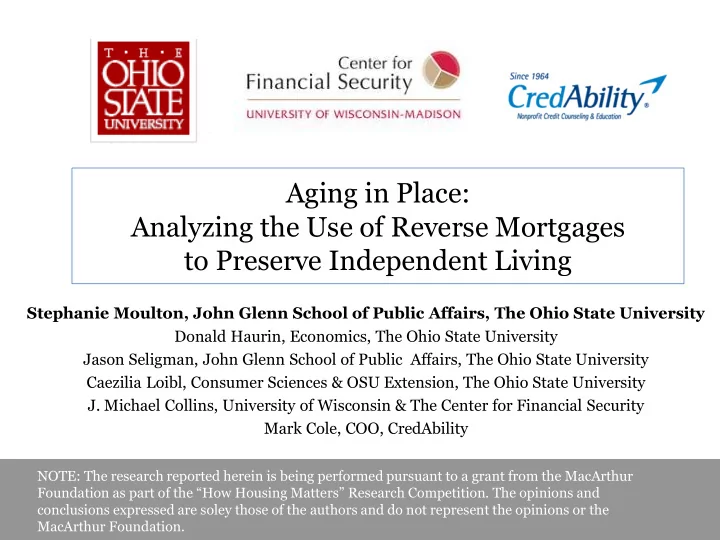

Aging in Place: Analyzing the Use of Reverse Mortgages to Preserve Independent Living Stephanie Moulton, John Glenn School of Public Affairs, The Ohio State University Donald Haurin, Economics, The Ohio State University Jason Seligman, John Glenn School of Public Affairs, The Ohio State University Caezilia Loibl, Consumer Sciences & OSU Extension, The Ohio State University J. Michael Collins, University of Wisconsin & The Center for Financial Security Mark Cole, COO, CredAbility NOTE: The research reported herein is being performed pursuant to a grant from the MacArthur Foundation as part of the “How Housing Matters” Research Competition. The opinions and conclusions expressed are soley those of the authors and do not represent the opinions or the MacArthur Foundation.
Policy Rationale for HECMs Financial Reverse Financial Increased Need Mortgage Security Well-Being Underlying Assumption: Reverse mortgages can provide seniors with greater financial security. Increased financial security combined with the ability to remain in one’s own home may lead to independence and overall well-being.
Take-Up of HECMs Number of Loans by Year 140,000 120,000 100,000 80,000 60,000 40,000 20,000 - Source: Author’s calculations from HUD HECM data
Shifting Dynamics • The pool of eligible HECM borrowers is growing. • Baby boomer generation turning 62 years old. For half of homeowners aged 62 and older, equity is their primary asset • The age of the average HECM borrower is getting younger. • Nearly half of borrowers in FY2011 were in their 60s, compared with fewer than ¼ in FY2000. (Spike at age 62). • More HECM borrowers have mortgage debt. • More than 65% in 2010, compared with less than 50% in early 2000s. • Increase in the amount drawn at closing; pending limits to lump sum. • 75% of borrowers drew 90%+ of funds at closing in 2010, compared with 43% in 2008. High demand for the fixed rate, lump sum product. • More borrowers default on property taxes and insurance. • 9.8% of borrowers as of June, 2012
Previous Research • Potential demand for reverse mortgages • Venti and Wise 1991; Merrill, Finkel, and Kutty 1994; Rasmussen, Megbolugbe, and Morgan 1995; Mayer and Simons 1994; Costa-Font, Gil, and Mascarilla 2010; Shan 2011; Nakajima and Telyukovaz 2011; Davidoff 2012; Haurin, Ma, Moulton & Seligman 2013 • Performance of reverse mortgages • Szymanoski 1994; Chinloy and Megbolugbe 1994; Szymanoski, DiVenti, and Chow, 2000; Rodda, Herbert, and Lam 2000; Shiller and Weiss 2000; McConaghy 2004; Szymanoski, Enriquez, and DiVenti 2007; Yuen-Reed and Szymanoski, 2007; Davidoff and Welke 2007; Bishop and Shan 2008; Kolbe and Zagst 2010; Cushman, 2011 • Borrower Characteristics • Case and Schnare 1994; Rodda, Herbert, and Lam 2000; DeNavas-Walt, Proctor, and Lee 2006 ; Redfoot, Scholen, and Brown 2007
Previous Research • Potential demand for reverse mortgages • 80% of households over age 62 own homes; equity primary source of wealth for more than half of seniors • Costs versus benefits; House price increases (and decreases); reverse mortgages may provide a form of insurance against house price volatility • Performance of reverse mortgages • Reverse mortgages terminate earlier than underlying mortality rates in the general population (average duration 7 years, 10 year survival rate of 22%); Adverse selection? • Borrower Characteristics • Reverse mortgage borrowers tend to be older, female-headed households that are better educated than the general population of senior homeowners. • Tend to have lower incomes (40% lower), but more equity; although 40% reported using the reverse mortgage to payoff an existing mortgage in 2007.
Unanswered Questions 1. What factors affect consumer decisions about whether or not to get a reverse mortgage and the structure selected (e.g. fixed vs. arm, lump sum, tenure)? 2. How do consumers use the proceeds of the reverse mortgage? 3. What factors affect early termination decisions (including T&I default as well as repayment) ? 4. What impact do the decisions about (1), (2) and (3) have on longer term outcomes of financial security and well-being ?
Life Cycle Model of Reverse Mortgages • Predict the decision to obtain a reverse mortgage (empirical model including counseled seniors who received and did not receive a reverse mortgage), and terms of reverse mortgage selected; and • Empirically evaluate the impact of the reverse mortgage on measures of longer term well-being (financial using credit report data, and quality of life using survey data)
Data Sources 1. CredAbility reverse mortgage counseling data for the years 2006 to 2012, including more than 30,000 seniors; 2. Credit report data at the time of counseling, and annual credit report data thereafter; 3. Data from the Financial Interview Tool, collected at the time of counseling; 4. Loan level HECM data from HUD’s HECM database, including information on T&I defaults; 5. Survey data to be collected (June-July 2013) from current HECM borrowers, terminated HECM borrowers, and seniors who sought counseling but did not get a reverse mortgage.
Sample Data Cause of Financial Problem, Clients Counseled for Reverse Mortgages, 2009-2011 N % INCREASE MONTHLY INCOME 9446 38.0% MAKE HOME REPAIRS 1756 7.1% PAY OFF EXISTING MORTGAGE 9427 37.9% PAY OFF OTHER DEBTS 2740 11.0% OVER OBLIGATION 2083 8.4% REDUCED INCOME 2604 10.5% PROVIDE FOR EMERGENCY EXPENSES 1768 7.1% Source: CredAbility Counseling Data
Sample Data Credit Report Characteristics, Clients Counseled for Reverse Mortgages, 2009-2011 %/Median N Credit Score (Median) 688 24,253 Revolving Account Past Due (%) 16.21% 18,388 Revolving Amount Past Due (Median) $570 2,980 Percent with a Medical Collection (%) 36.24% 24,253 Total Debt (Median) $45,559 22,933 Have a First Mortgage (%) 46.70% 24,253 Balance of 1st Mortgage (Median) $83,256 11,327 Mortgage Past Due (%) 18.10% 11,327 Number of Mortgage Payments Past Due (Median) 5 2,057 Source: CredAbility Counseling Data
Proposed (Pending) Extensions • Improved estimation of early termination probabilities for different subsets of borrowers, based on up-front borrower characteristics and draw behaviors • Design, implementation and testing of post-origination monitoring system to prevent early termination (could include different escrow models for T&I) • Other Ideas?
Recommend
More recommend